Shaping Vancouver 2018: Conversation 2
Change in Living Communities - False Creek SouthOctober 11, 2018
In this session of Shaping Vancouver, we explore how we can expand our understanding of heritage, and the role that heritage can play as Vancouver plans for the future. Moderator Bill Yuen introduced the changing attitudes towards the concept of heritage, and how ideas, meanings, and people’s connections to place are all important aspects to heritage. This holistic and “humanistic” approach to heritage parallels the planning experience of False Creek South, which is defined by prioritizing human experience. In this session, the panelists discussed this vision and the value that False Creek South’s particular heritage brings to Vancouver’s future.
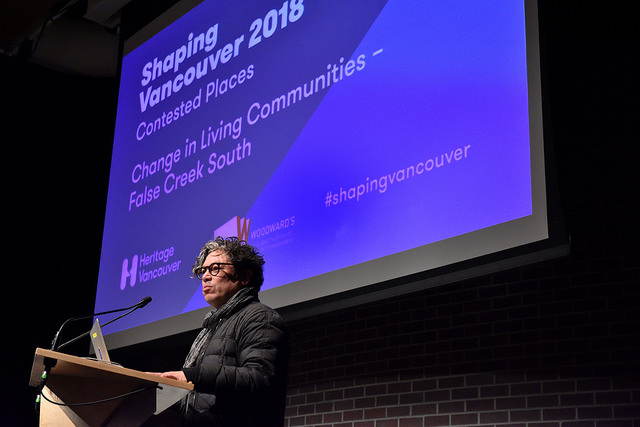
Moderator
Bill Yuen:
- Executive Director of the Heritage Vancouver Society
Panelists
John Atkin: Civic historian, author and Vancouver-based heritage consultant
Nathan Edelson: Project Manager at False Creek South *RePlan and former Senior Planner for the Downtown East Side, City of Vancouver
Tom Davidoff: Director, Centre for Urban Economics and Real Estate Associate Professor, Strategy, and Business Economics at UBC’s Sauder School of Business
Jennifer Maiko Bradshaw: Renter and pro-housing activist with Abundant Housing Vancouver
False Creek South is a 55-hectare stretch of waterfront land between the Burrard and Cambie bridges, characterized by extensive green spaces and a diverse mix of housing types. The design of this community has its roots in the values-based social planning that was revolutionary when introduced in the 1970s and 80s. By giving priority to values associated with quality of life and a livable city, this area was created with diversity in housing options, including non-market rental housing, co-ops, and condominiums in a “Garden City” setting geared to a pedestrian culture.
The lease agreements, with strata leasehold owners, co-ops and non-market housing operators that made this diverse mix of housing possible, will begin to expire in 2025. The City, which owns approximately 80% of False Creek South, has begun to explore the future of this neighbourhood and its residents. There are many additional issues: the diversity of people supported by the current housing mix central to this community; development along the edges of the area; and retention and redevelopment of the existing urban fabric. False Creek South is an example of how values-based community planning can integrate with the ever-evolving urban fabric of the City.
Panelists
John Atkin – Civic historian, author, and heritage consultant
Nathan Edelson – Project Manager at False Creek South *RePlan and retired Senior Planner for the Downtown Eastside, City of Vancouver
Tom Davidoff – Director, Centre for Urban Economics and Real Estate Associate Professor, Strategy and Business Economics BC Sauder School of Business
Jennifer Maiko Bradshaw – Renter and a pro-housing activist with Abundant Housing Vancouver.
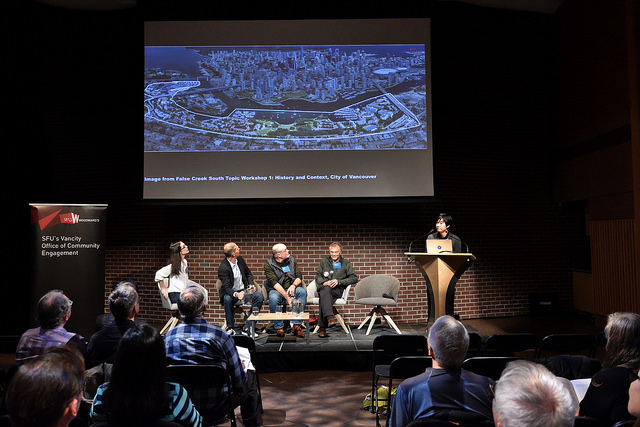
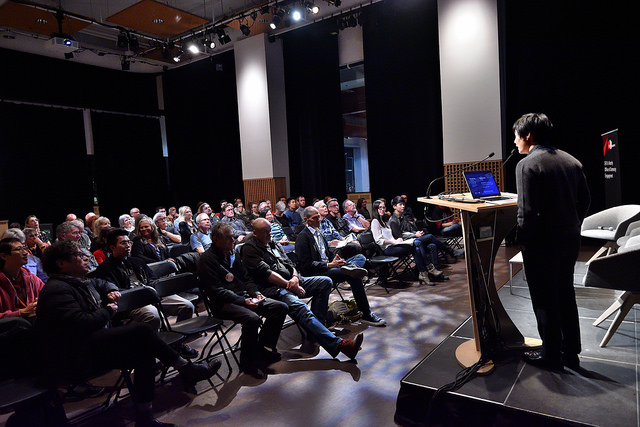
Is False Creek South “heritage”? (3:14)
Bill Yuen opened the discussion by introducing the area of False Creek South, which sits across the water from Vancouver’s Downtown Core. The two sides of False Creek represent two distinct planning patterns. On both sides, there were plans to develop the waterfront for residential use, but the two areas took on very different characteristics. One of the defining characteristics of False Creek South is that it is a master-planned community, distinguished by its explicit aim for a diverse mix of residents to represent a microcosm of Vancouver. This was quite a break from the modernist planning trends of the time, and was done to plan with people in mind. This marked an inclusive, ‘humanistic’ approach to planning not seen elsewhere in Vancouver at the time.
Many people ask if False Creek South counts as heritage. While lots of people make a strong association between heritage and ‘old buildings’, there are in fact other aspects of heritage that False Creek South exemplifies. One important aspect of the heritage of False Creek South is the way in which at the time it was planned with the values of inclusivity and diversity. It is also a unique, living community in the present, which is shaped by those values. This particular vision behind False Creek South’s master-plan provides contemporary Vancouver with alternative paths to address current planning issues.
The current overriding issue facing False Creek South is the renewal of the property leases. As Vancouver faces a housing crisis, some have called for densification of False Creek South, while others fear that this would threaten the affordability and intrinsic character of the neighbourhood.
What is *RePlan, and what is its goal going forward with regard to the lease negotiations? (11:31)
Nathan Edelson responded by explaining the origins of *RePlan, which was established over the past decade as a committee of the different neighbourhood associations in False Creek South. The purpose of *RePlan was simple—get the leases renewed, and respect the character of the neighbourhood. Speaking to his organization’s intent, Nathan explained that “Not every stick and stone needs to be protected, but the overall character and founding spirit of the neighbourhood should be preserved.”
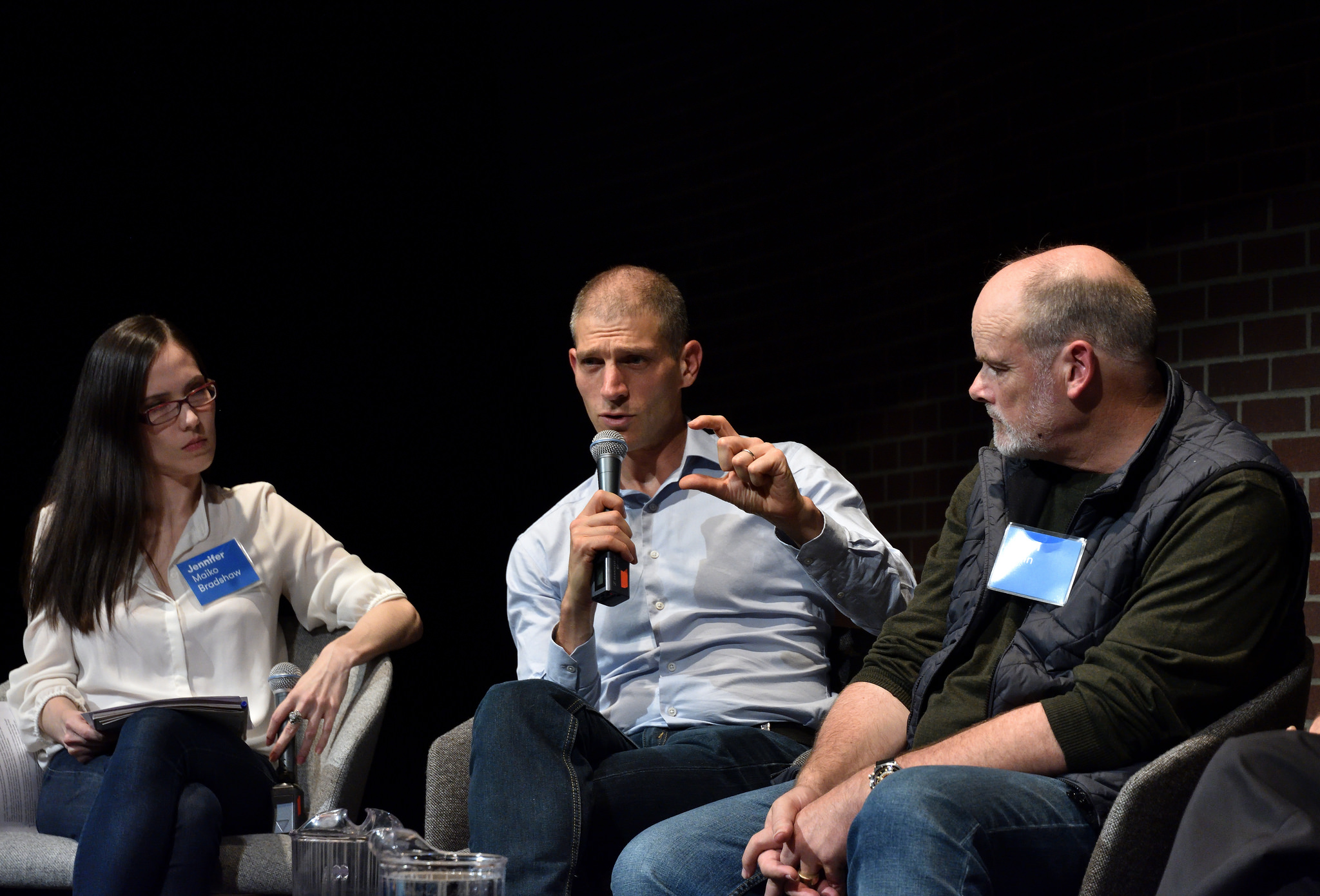
From a housing perspective, what is the value of the low-rise residential developments that are prevalent in False Creek South? (20:25)
Tom Davidoff commented that False Creek South is a “spectacular piece of planning,” and that neighbourhood residents should be allowed to renew their leases. However, he went on to explain that in his view, the City should not give up a huge capital opportunity by renewing all the leases at the older, lower rates. Davidoff stated that density should be proportional to land value, and that as the land value in Vancouver has shot up a thousandfold since False Creek South was planned, any re-planning now should be done vertically. But he insists that the neighbourhood can be made vertical in a sensitive way. This entails densifying False Creek South “opportunistically” while keeping it beautiful.
What are your thoughts on False Creek South potentially going vertical? (30:53)
John Atkin first responded by speaking to the strong aesthetic that the neighbourhood embodies, which is strongly linked to its low-rise nature. Disrupting that aesthetic doesn’t make sense to Atkin, who also made the point that when False Creek South was first planned, it was criticized for being too dense. While today some would say that the space is ‘under-utilized’ its lower density is an important part of its character.
Jennifer Maiko Bradshaw added that her organization, Abundant Housing Vancouver, advocates for densification in Vancouver as long as it is not disruptive (32:27). She believes that the attention being paid to False Creek South is misplaced, as there are a number of places in the City that are more suited to densification. On 76% of the land in Vancouver, zoning bylaws prohibit densification. Rather than focus on putting towers in False Creek South, the City should look at allowing for densification throughout Vancouver.
Nathan Edelson also contributed, pointing out that the density of False Creek South is approximately twice the average of the city generally (34:26). Edelson believes we should look to the rest of the city and ask how it can be densified in a way that makes sense to communities. Rather that try to make it vertical, Nathan believes we can expand the model of False Creek South, rather than erase precious pieces of the city’s history.
What defining characteristics of False Creek South should be protected?
John Atkin stated that while the neighbourhood consists of iconic architectural trends and the physical aspect of False Creek South’s architecture should be protected, the semi-public/semi-private layout of the neighbourhood is more important. To Atkin, the value of False Creek South is bound up in its distinctive landscape and its character of isolation. Furthermore, Atkin made the case that False Creek South represents the beginnings of modern Vancouver, because it embodies the value that the city should not just be a place where people work then leave, but one where people work, live, and enjoy.
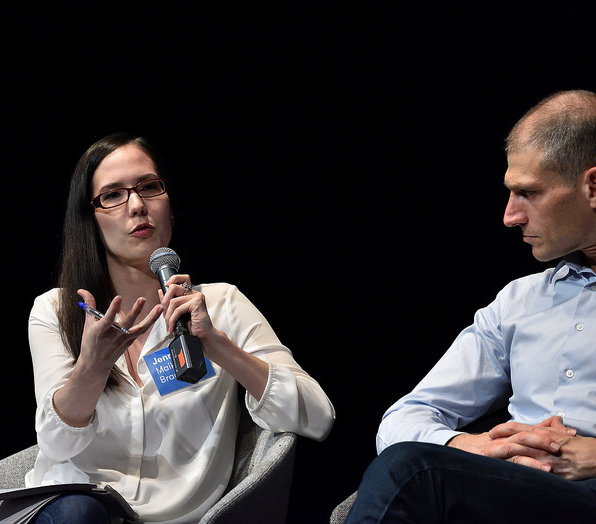
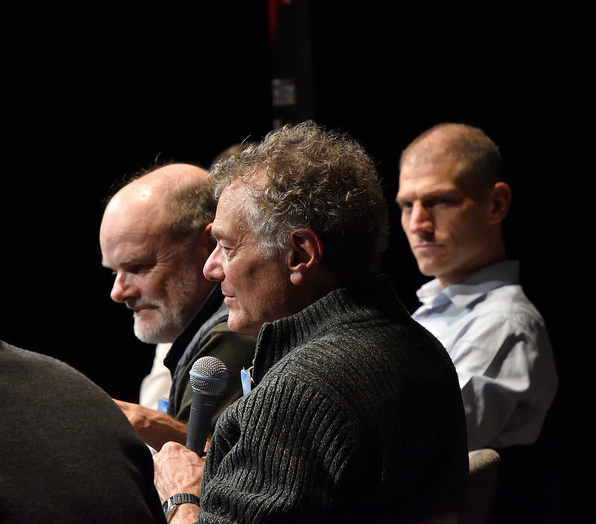
Can the model of False Creek South be exported elsewhere in Vancouver? (37:05)
Tom Davidoff reflected on his Real Estate background and argued that while there has been a lot of talk of the “Missing Middle” with regards to apartments and duplex housing, he believes that this is not the best way forward. To Davidoff, the worst way forward would be in to increase density “just a little”. Because then everyone in a single-family neighbourhood will build more densely, leading to homeowners getting a little extra money but then the neighbourhood character is sacrificed anyway. At that point, Davidoff argues that “you might as well just go all the way to towers”.
What is the City’s perspective on False Creek South? It is important to note that the City government consists of many different departments with different resources and objectives. (39:15)
Tom Davidoff responded by saying that we should look at the City comprehensively, and see their objectives through an economic lens. Davidoff sees Vancouver’s Real Estate as a “potentially trillion-dollar resource that the City is sitting on” and that the government can take advantage of this resource through zoning. The City’s Real Estate planners want to extract that resource, but without turning the whole city into a construction zone at once. So the question is which development ‘valve’ should the City open first? To Davidoff, the City should focus on optimally densifying other neighbourhoods–such as Dunbar and Kerrisdale–before turning to False Creek South.
Nathan Edelson added that the real question that the City should be asking is “What do we value as a city?” To *RePlan, the answer is to build great communities that people want to live in (41:44). The leadership of *RePlan is looking to be more inclusive, as the community values in False Creek South are inclusivity and diversity. This objective is shown by False Creek South’s tackling cutting-edge progressive issues like modular housing to alleviate homelessness and welcoming refugee families. *RePlan’s goals today are to extend that idea and be a progressive voice on the next big issues, not just worry about lease agreements for those in neighbourhood now. Jennifer Maiko Bradshaw added her thoughts on *RePlan’s work, saying that it is valuable to have an organization dedicated to realizing progressive values, but also pointing out that False Creek South today is older, richer, and more homogenous than the city average (44:21).
What in False Creek South should be improved? (45:50)
John Atkin began by explaining that False Creek South has not been commercially successful. Initially, it was “a daring thing” to put retail in the development plans themselves rather than following a traditional separation of use. But population density was too low to support local businesses. False Creek South is unique for its courtyards, pathways, and small-scale retail which was dotted through the city. At the time it looked “really cool”, but the population was too low to support the “hidden store around the corner” as intended. John continued by explaining how the planning aspirations were unique, but it didn’t work out as hoped because the time’s understanding of how places work were not as fine tuned as they are now. False Creek South’s isolation helped kill the retail dream, and hampered the success of the experiment. More recent planned development, such as the Olympic Village, better prioritized connections between retail and residential uses, thereby creating a very active place to work and live.

Should the City be looking at False Creek South in economic terms, or does that conceptual framework miss the importance of the neighbourhood’s plan? (48:53)
False Creek South is distinct from the rest of Vancouver specifically because it looked at its community in human terms, rather than economic ones. In response, Tom Davidoff expressed that a monetary value should be attached to the public space in False Creek South, in order to make an apples-to-apples comparison with the rest of the city. Additionally, Davidoff repeated that the City has access to “hundreds of billions” of dollars worth of Real Estate. By not optimally using this resource, the City would be forgoing huge amounts of capital, and the management of this resource is what must drive affordability.
However, Nathan Edelson believes that if we follow the logic of quantifying all of the costs of redeveloping Vancouver, then we also must think of the costs of people being displaced, seniors being able to age in place, or young people being alienated in their city. The question then becomes “Who are we making the city affordable for? (53:36)” Edelson continued by asking if we know how to make strong, sustainable communities in high-rises. In today’s Vancouver, high-rise developments offer a mix of positive and negative impacts to communities. Adding on, Jennifer Maiko Bradshaw stated that statistically speaking, areas with lower density tend to have higher average incomes, and that higher density doesn’t necessarily equate to more affordability.
Lastly, John Atkin added that there are actually a number of ways of managing density while taking care to preserve the character of a neighbourhood (58:12). Pointing to his own neighbourhood of Strathcona, Atkin explained how density shows up in many forms, including cut houses and detached units. Atkin says that no one complains about the loss of character in Strathcona, and that it is possible to densify a neighbourhood in non-damaging ways. Therefore, it is possible to balance the need for a neighbourhood to change with its unique heritage.
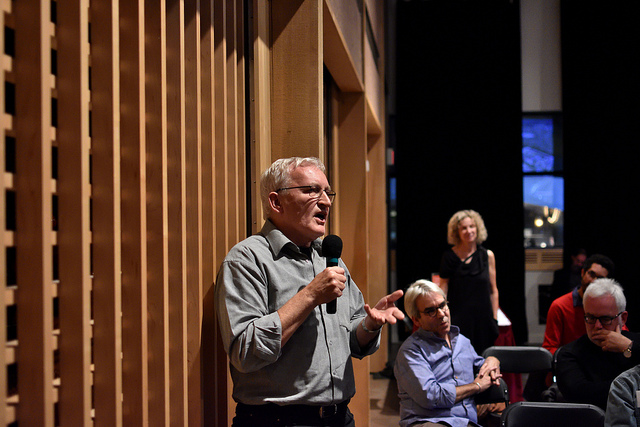

Questions from the audience
For me, the biggest heritage issue in False Creek South is the diversity of housing options, what are the panel's thoughts on this?
Tom Davidoff responded in agreement, explaining how mixed-use development leads to great, more liveable neighbourhoods. Going on, Davidoff said “Currently in places liked Kerrisdale and Oakridge there is a problem, this is among the most valuable Real Estate in the world, and the neighbourhoods produced aren’t as livable as they could be.” Diversity in street life, such as what is exemplified in False Creek South, should be aspired to in future planning.
(1:00:17)
The land value now is significantly higher than in 1976. We went in to the planning process with the expectation that the land would be redeveloped when the leases expire, but the mood today is such that the property should not revert to the City. Would you support some 'gentle intensification' in this area, particularly around the old railway?
Nathan Edelson responded by making clear that *RePlan is open to new development within False Creek South. For example, the only concern that *RePlan expressed about the temporary modular housing was its proximity to the Olympic Village. At this point, our bigger concern is in measuring the success of this project and finding a way to make permanent housing for new residents. This is important to note because it shows that some of the attitudes have changed quite a bit. Some intensification is actually what *RePlan wants to introduce through community planning.
(1:02:21)
Vancouver is known around to world as an attractive place to live, but we sometimes ignore city beautification. Why do we in Vancouver not put more emphasis on this?
Jennifer Maiko Bradshaw jumped in, pointing out that “There are thousands of people still homeless in Vancouver. The modular housing project in False Creek South put in 600 houses for $66 million. If we had the money to invest in beautification like in other cities around the world, then we could fix the homelessness problem in Vancouver.” While she agrees that there are many things that Vancouver could do to further beautify the city, the priority must be put on the people who are most vulnerable.
(1:09:15)
As a resident of False Creek South, I would like to hear more about how this community model provides affordable housing. The City owns the land, making all of the tenure types more affordable than they would be otherwise. City-leased land is amenable to providing affordable housing. Rather than "mining" the land by extracting value from it, it could "farm" it. What are your thoughts?
(1:11:20)
Tom Davidoff replied by saying “When you talk about middle-class households, you have to be careful about what model you follow to maximize affordability. (1:13:04)” The number of people who want to age in place in False Creek South is not close to the number of people who want to live in Vancouver but are struggling with affordability. The City could hold the land below market value, and then put families in a lottery to decide who gets to live in those houses with artificially low rents, or you could say lease the land on market value and put the subsidy money to more efficient uses.
Moderator Bill Yuen then questioned Tom’s reference to subsidized housing as a ‘lottery’, saying that as housing is a basic necessity people buy lottery tickets and look for affordable housing for very different reasons (1:16:08). In response, Tom clarified that he is critical of the government for taking huge capital resources and then giving a “small number of people a big benefit, rather than giving a big number of people a small benefit. Is this really the best way to help people in need?”
Cutting in, Nathan Edelson commented that “Market-value land does not seem to generate affordability. The problem isn’t an unavailability of units to live in, but the unavailability of units that are affordable. (1:17:13)” Tom in response explained that in his view “That is because there are more people in the world with resources who want to live here than there are units in Vancouver. So we can and should build more units, and when public resources are at stake then a hand should be given to people in need.” Going on, Davidoff explained that in his view the affordability problem cannot be easily solved because Vancouver is a very desirable place to live and there are many people living in other cities around the world who “would kill to live in Vancouver,” and that it is “not mathematically possible to fit everyone who wants to live in Vancouver in Vancouver, so the question should be “What is the best way to provide assistance to people in need?”
Nathan, in response, said that it depends on what a city values, and the kind of city that we want to leave to the future. “The way that we try to maintain diversity is through regulation,” and then added “We have something that works now and reflects the values of many people in the community. We should look at what the values are that we want to put forward,” and that planning for liveable and diverse cities involves more than simply making room for the number of people who want to live in Vancouver.
We are facing smaller and smaller units that cost more and more, how do we change our economic thinking around redevelopment?
Tom Davidoff stated that False Creek South is a really good model, whereas a lot of the city is built on pretty bad models in his view. The problem in other neighbourhoods is that there was never enough public benefit. Davidoff called for making the process simpler, and then to “have fools from all over the world overpay for the right to develop, and overbuild until we have better affordability”. Ultimately, to Davidoff, False Creek South has done a lot of work for affordability, it is time for the rest of the city to chip in as well.
Adding on, Jennifer Maiko Bradshaw cleared up the fact that while many people equate high-rises and vertical development with unaffordability, that is not necessarily the case. The problem with the affordability of high-rises has more to do with the fact that new developments are new. New buildings always are more expensive, but decades down the line the units become cheaper. Continuing, she stated that it is actually beneficial to everyone to build expensive new units, because otherwise high-income people would want to move into relatively cheaper buildings and price out the people currently living there.
Is this like a streetcar suburb, simply without the streetcar?
Two panelists said “No, simply because we are hoping to bring back the streetcar.”
Other audience comments
From a resident of False Creek South
“Not everything devolves into money–there are other values, such as issues of social equity. False Creek South is not entirely successful on a number of fronts, very largely because of the lease issues. The demographic makeup is not what was intended: The community is older than the city average, and not as ethnically diverse as it should be.
“However, one important thing for this resident is that “the children of this community do not know where they live,” as they are so integrated with each other that they do not know if they live in a house, a co-op, an apartment, or any other housing arrangement.
“We have cracked a code, [namely] how to get rid of an income ghetto. While not being perfect–the neighbourhood needs more low- and moderate-income people, the goal of False Creek South is very desirable.”
(1:21:28)
From a member of *RePlan
“We [at *RePlan] are coming from the concept of “embedded affordability value”. We want to know what should be valued: empty land, or do you say that housing is like food. You need to replenish it, pay it each month through a mortgage or rent. In False Creek South we can do that as a community, maintaining all of our needs.
“We, the community, could be self-actualized. We are used to borrowing millions of dollars, we’re like mini-developers in that we know and understand the due diligence needed. In this neighbourhood, a self-actualizing community is proposing that we be part of the redevelopment of False Creek South.
“A community has come together, co-ops, non-profit rentals, et cetera, all looking at radically different models to move forward.”
(1:30:22)
From a long-time Vancouver resident
“To me, going forward we will need to focus on design with democracy. I don’t believe in putting in towers as the way forward.
“False Creek South presents an opportunity moving forward to, because it is a place that has that mixed old-Vancouver and new-Vancouver feeling that comes with a range of housing options. We don’t have that elsewhere in the city.
“Moving forward, we have to keep this neighbourhood as an example to the world, to show that we can in fact have a mix of neighbourhoods, that we can have good design, because we seem to have forgotten that.”
We acknowledge the financial assistance of the Province of British Columbia. Thank you to SFU’s Vancity Office of Community Engagement for co-presenting the series.
All photo credits go to roaming-the-planet.